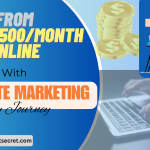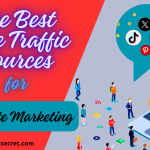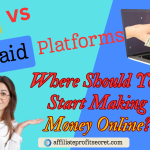Welcome to my article on “How to Use Social Media to Drive eCommerce Traffic”. If you’re running an eCommerce business and not using social media to drive traffic, you might as well be opening a store in the middle of the desert—without a sign. With billions of users scrolling, liking, and shopping daily, social media isn’t just for memes and cat videos anymore (though, let’s be honest, those still rule the internet). It’s a goldmine for online stores looking to attract customers, boost brand awareness, and, most importantly, increase sales.
But here’s the catch: simply posting a product photo and hoping for a sales boom won’t cut it. Social media success requires strategy. From choosing the right platforms and creating share-worthy content to leveraging influencer marketing and running targeted ads, there’s a method to the madness. And don’t worry—I’ll walk you through it step by step, with practical tips to turn those likes into actual sales. So, grab your coffee (or energy drink, no judgment), and let’s dive into how you can use social media to drive traffic to your eCommerce store—without getting lost in the algorithm jungle.
Access My Recommended Formula for $50-$100 Daily Income – Watch This FREE Video Now >>>

Choosing the Right Social Media Platforms for Your Business
Let’s be real—trying to be active on every social media platform is like juggling flaming torches while riding a unicycle. 🫠 It’s exhausting, chaotic, and, unless you’re a circus performer, not the best strategy. The key to success isn’t being everywhere—it’s being where your customers are.
So, how do you choose the right platform for your eCommerce business? Glad you asked.
1. Know Your Audience (Because Not Everyone Hangs Out in the Same Place)
Different platforms attract different crowds. Teenagers? They’re probably on TikTok. Millennials? Instagram is their playground. DIY enthusiasts and home décor lovers? Pinterest is calling their name. And if you’re selling B2B products, LinkedIn might be your best friend. Before diving into social media marketing, research where your ideal customers spend their time—otherwise, you’re just shouting into the void.
2. Match the Platform to Your Product Type
Some platforms are visually driven, while others thrive on text-based discussions. Here’s a quick cheat sheet:
- Instagram & TikTok – Perfect for fashion, beauty, and lifestyle brands. If your products look great in photos or videos, these are must-haves.
- Facebook – Great for businesses targeting a broad audience, running ads, and building community groups.
- Pinterest – A powerhouse for eCommerce, especially for home decor, fashion, wedding planning, and DIY products. People come here ready to buy.
- LinkedIn – If you sell B2B products (think software, professional services), LinkedIn is where you’ll find serious decision-makers.
- Twitter/X – Best for tech, news, and brands with a strong voice (or an endless supply of witty comebacks).
3. Start Small and Scale Up
You don’t need to launch on five platforms at once. Pick one or two where your audience is most active, master them, and then expand. Otherwise, you’ll spread yourself too thin—like that last bit of peanut butter on toast.
By choosing the right platforms, you’ll maximize engagement, drive more traffic, and avoid wasting time on social media ghost towns. Up next? Creating content that actually gets people to click, buy, and come back for more.
Creating Engaging and Shareable Content
Here’s the harsh truth: No one logs onto social media thinking, “Wow, I can’t wait to see some ads today!” People want entertainment, inspiration, and value—not a never-ending sales pitch. If you want to drive traffic to your eCommerce store, your content needs to be so engaging that people can’t help but like, comment, and share (and, of course, click that link to buy).
So, how do you create content that stops the scroll? Let’s break it down.
1. Make It Visual (Because Nobody Reads Blocks of Text)
Social media is a visual playground, and your content should be, too. Whether it’s high-quality product photos, behind-the-scenes videos, or eye-catching graphics, your goal is to grab attention in milliseconds.
- Instagram & TikTok → Short, snappy videos work best. Show off your products in action, share tutorials, or hop on viral trends.
- Pinterest → Aesthetic, high-quality images are a must. Think lifestyle shots, infographics, and step-by-step guides.
- Facebook & Twitter/X → A mix of images, videos, and well-crafted text posts. Memes? Yes, please.
2. Tap Into User-Generated Content (UGC)
Nothing builds trust like seeing real people using your products. Encourage customers to share photos, videos, and reviews, then feature them on your social media. Not only does this make your brand feel more authentic, but it also turns happy customers into brand ambassadors—without paying influencer prices.
3. Leverage Storytelling Over Sales Pitches
Instead of just posting “Buy this now!”, tell a story. Why does your product matter? How does it solve a problem?
- Before & After posts – Show transformations using your product.
- Behind-the-scenes content – Give a peek into your brand’s journey.
- Customer testimonials – Highlight real experiences (bonus points if they include video).
People connect with stories, not just products. Give them something worth following.
4. Hop on Trends (But Keep It Authentic)
Trends move fast, and brands that jump on them at the right time can go viral overnight. Whether it’s a trending TikTok sound, a viral meme, or a hashtag challenge—join the conversation in a way that fits your brand. Just don’t force it. No one wants to see a bank trying to do a Gen Z dance challenge. 🫠
5. Write Captions That Spark Engagement
A great post without an engaging caption is like a great joke with no punchline—it just doesn’t land. Your captions should:
✅ Ask questions to encourage comments (“Which color would you pick?”)
✅ Use call-to-actions (“Tag a friend who needs this!”)
✅ Be short, witty, and in line with your brand’s personality
Access My Recommended Formula for $50-$100 Daily Income – Watch This FREE Video Now >>>
At the end of the day, social media success = content that people actually want to engage with. If you can make people stop, smile, or think, you’re on your way to driving serious eCommerce traffic. Up next? How influencers and affiliates can help supercharge your reach.
Leveraging Influencer and Affiliate Marketing
Let’s face it—people are way more likely to trust a recommendation from their favorite influencer than a random ad from a brand they’ve never heard of. That’s the magic of influencer and affiliate marketing. It’s like having an army of people raving about your products—without you having to do all the talking.
So, how do you make influencers and affiliates work for your eCommerce business? Let’s dive in.
1. Find the Right Influencers (Hint: Bigger Isn’t Always Better) 👀
When brands hear “influencer marketing,” they often think of mega-celebrities with millions of followers. But unless you have Kardashian-level marketing budgets (spoiler: most don’t), micro and nano influencers (1K–100K followers) are your best bet.
✅ They have highly engaged audiences.
✅ Their followers trust them more than big influencers with generic endorsements.
✅ They’re way more affordable (some even accept free products in exchange for content).
Look for influencers in your niche—whether it’s fashion, fitness, beauty, tech, or home decor. A small, loyal audience that actually listens is far more valuable than a massive following that just scrolls past.
2. Make Collaborations Feel Natural (Because Fake Endorsements Are Cringe) 🤦♂️
The quickest way to make influencer marketing flop? Forcing a scripted, salesy post. Influencers know their audience better than anyone, so give them creative freedom! Instead of just saying, “Promote our product,” try:
✅ Unboxing videos – First impressions always feel authentic.
✅ Tutorials or How-To’s – Show the product in action.
✅ Lifestyle shots – Make it feel natural, not staged.
If the endorsement feels forced or fake, people won’t buy into it—literally.
3. Turn Happy Customers into Affiliates
Why stop at influencers when you can turn real customers into salespeople? That’s where affiliate marketing comes in. You set up a referral program, and every time someone drives a sale, they get a commission. Win-win.
How to do it?
- Use platforms like Refersion, Impact, or Shopify’s affiliate tools to set up tracking.
- Offer a compelling commission rate (10–30% is standard).
- Give affiliates a unique discount code to share—it makes them look like a hero, and you get more conversions.
Customers already love your brand—why not reward them for spreading the word?
4. Use UGC (User-Generated Content) to Maximize Results
Once influencers or affiliates create content, don’t let it disappear into the algorithm abyss. Repurpose their posts for:
✅ Instagram & Facebook Ads – UGC-based ads often outperform traditional ones.
✅ Your website – Feature real people using your product.
✅ Email marketing – “Look how much people love us!” sells better than “Please buy this.”
5. Measure What’s Working (And What’s Not) 📊
Not all influencer campaigns are created equal. Track:
📈 Engagement (likes, comments, shares)
💰 Sales driven by influencer/affiliate links
👀 Overall brand awareness (Did your follower count grow?)
If an influencer’s audience loves your product, consider an ongoing partnership. If not? Learn and refine your approach.
Final Thoughts
Influencer and affiliate marketing are powerful tools for eCommerce, but the key is authenticity. People can spot a fake promo from a mile away. Focus on genuine partnerships, and soon, you’ll have a network of influencers and affiliates driving traffic—and sales—straight to your store.
Running Paid Social Media Ads for eCommerce
Let’s be honest—organic reach on social media is about as reliable as my gym attendance in January. Algorithms change, engagement fluctuates, and even your most fire posts can get buried under a sea of cat videos. That’s where paid social media ads come in. When done right, they can put your products in front of the right people, at the right time, and drive serious traffic to your eCommerce store.
Access My Recommended Formula for $50-$100 Daily Income – Watch This FREE Video Now >>>
But let’s not just throw money at Meta (formerly Facebook) and hope for the best. Here’s how to actually make paid ads work for your eCommerce business.
1. Pick the Right Platforms (Because Not All Ads Perform the Same Everywhere)
Different platforms = different audiences. Here’s a quick cheat sheet:
- Facebook & Instagram Ads – Best for visual storytelling and retargeting past visitors. Perfect for fashion, beauty, home decor, and lifestyle brands.
- TikTok Ads – Great for viral potential. Works well for Gen Z-targeted products and fun, engaging brands.
- Pinterest Ads – Ideal for inspirational shopping. People come here to plan purchases, making it perfect for home decor, fashion, and DIY products.
- YouTube Ads – Best for product demos and tutorials. Great for tech, fitness, and beauty brands.
If you’re just starting out, Facebook & Instagram Ads are a solid choice—they offer powerful targeting and work for most eCommerce niches.
2. Use the Right Ad Formats (Because Boring Ads Don’t Convert) 🎨
Not all ads are created equal. The format you choose matters just as much as the platform. Here are some top-performing ad types:
✅ Carousel Ads – Showcase multiple products in a single ad (great for fashion and accessories).
✅ Shoppable Ads – Let users buy directly from the platform (perfect for impulse purchases).
✅ Video Ads – Short-form videos (10-30 sec) perform best—especially on TikTok and Instagram Reels.
✅ Retargeting Ads – Bring back visitors who abandoned their carts (yes, we see you, window shoppers 👀).
Pro Tip: Avoid generic product photos—use UGC (User-Generated Content) or influencer clips to make ads feel authentic.
3. Target the Right Audience (Because If You Target Everyone, You Target No One)
One of the biggest mistakes in paid ads? Going too broad. The best part about social media ads is the crazy-specific targeting.
🎯 Cold Audience Targeting (Finding New Customers)
- Lookalike Audiences – Facebook & Instagram can target people similar to your current customers.
- Interest-Based Targeting – Show ads to people who follow competitors or similar brands.
- Demographics & Behaviors – Target by age, location, shopping behavior, and more.
🔥 Warm Audience Targeting (Retargeting for Conversions)
- Website Visitors – Show ads to people who browsed but didn’t buy (remind them why they need that cart-full of goodies).
- Engaged Social Media Users – Target people who liked or commented on your posts.
- Email List Subscribers – Turn email leads into paying customers with exclusive discounts.
Pro Tip: Always start with warm audiences first—they’re cheaper to convert!
4. Optimize Your Ads (Because Wasting Money Is Not the Goal)
Throwing money at ads without optimizing is like pouring water into a bucket with holes—it just leaks everywhere. Here’s how to stop wasting ad spend:
📊 A/B Test Everything – Test different headlines, images, and ad formats to see what works best.
⏳ Use Retargeting Ads – 98% of visitors won’t buy the first time—bring them back with retargeting.
💳 Have a Clear Offer – Discounts, free shipping, or limited-time deals increase conversions.
Pro Tip: Check your ad metrics daily and adjust as needed. If an ad isn’t performing, don’t be afraid to tweak or turn it off.
5. Measure Success (Because Guessing Isn’t a Strategy)
You don’t just set and forget paid ads—you track results and optimize based on what’s working. Key metrics to monitor:
✅ CTR (Click-Through Rate) – Are people actually clicking your ad? (Aim for 1%+ on Facebook/Instagram.)
✅ CPC (Cost Per Click) – Lower is better, but cheap clicks don’t always mean quality traffic.
✅ ROAS (Return on Ad Spend) – The golden metric. A ROAS of 3X+ means you’re making 3X your ad spend.
Use tools like Facebook Pixel, Google Analytics, and UTM tracking to measure performance and refine your strategy.
Final Thoughts
Paid social media ads can be a game-changer for eCommerce, but only if you do them strategically. Start small, test everything, and double down on what works. With the right targeting, creative, and optimization, your ads won’t just drive traffic—they’ll drive sales.
Tracking Performance and Optimizing Your Social Media Strategy
Running a social media strategy without tracking your performance is like cooking without tasting your food—sure, it might turn out great, but you’re also one bad ingredient away from disaster.
If you want to consistently drive eCommerce traffic (and sales), you need to know what’s working, what’s flopping, and what needs tweaking. Because here’s the thing—social media isn’t set it and forget it. It’s a constantly evolving game, and brands that adapt win big.
So, how do you track performance and optimize your strategy? Let’s break it down.
1. Define Your Key Metrics (Because Vanity Metrics Won’t Pay the Bills)
Likes and followers are cool, but they won’t keep the lights on. You need to track metrics that actually matter for your eCommerce business.
Here’s what to focus on:
✅ Traffic – How many people are clicking through to your website? (Google Analytics is your BFF here.)
✅ Conversion Rate – Are those visitors actually buying? If not, something’s off.
✅ Engagement Rate – Are people interacting with your content? More engagement = better reach.
✅ CTR (Click-Through Rate) – Are your posts and ads getting people to take action?
✅ ROAS (Return on Ad Spend) – If you’re running paid ads, is the revenue worth the cost?
Ignore the vanity metrics (10K likes are great, but if no one’s buying, what’s the point?). Focus on numbers that lead to actual sales.
2. Use the Right Tools (Because Guesswork Is Not a Strategy)
Lucky for you, you don’t have to track everything manually (unless you love spreadsheets, in which case… carry on). There are powerful tools that do the heavy lifting:
- Google Analytics – Tracks website traffic, conversion rates, and social media referrals.
- Facebook & Instagram Insights – See which posts and ads are performing best.
- TikTok & Pinterest Analytics – Track engagement, video views, and referral traffic.
- UTM Parameters – Add UTM tags to your links to track exactly where traffic is coming from.
- Third-Party Tools – Platforms like Hootsuite, Sprout Social, and Later help track performance across multiple channels.
Data = clarity. The more you track, the smarter your decisions.
3. Identify What’s Working (And Do More of That) 🚀
Not every post is going to be a winner (sad but true). Some will go viral, and others will be so quiet you can hear crickets chirping. 🦗
Here’s what to look for:
🔥 Top-performing posts – What type of content gets the most engagement? Videos? Carousels? Memes?
🔥 Best posting times – When is your audience most active? (Test different times and track results.)
🔥 Winning ad creatives – Which ads have the highest CTR and ROAS? Double down on what works.
Once you spot patterns, lean into them. If video content drives more traffic, make more videos. If engagement is higher on Wednesdays at 7 PM, schedule posts for that time.
Social media is about experimenting, analyzing, and repeating success.
4. Fix What’s Flopping (Because Ignoring It Won’t Help) 😬
Not every strategy works right away—and that’s okay. The key is figuring out why something isn’t working and tweaking it.
🚩 Low engagement? Maybe your content isn’t relevant or your captions aren’t compelling enough.
🚩 No website traffic? Your CTA (Call-to-Action) might not be clear, or your link might be buried.
🚩 High ad spend, low ROI? Maybe your audience targeting needs adjusting, or your landing page isn’t converting.
Instead of guessing, dig into the data. A small tweak (like changing an image or rewording a caption) can turn a struggling post into a high-performer.
5. Keep Testing and Adapting (Because Social Media Never Stays the Same) 🔄
Social media changes FAST. New trends pop up, algorithms shift, and what worked last month might flop this month. The brands that win are the ones that adapt and keep testing.
🔄 A/B Test Everything – Try different headlines, captions, and visuals to see what works best.
🔄 Experiment with New Trends – Hop on viral sounds, challenges, and memes (when relevant).
🔄 Stay Updated – Follow social media updates, algorithm changes, and competitor strategies.
Optimization isn’t a one-time thing—it’s an ongoing process. The more you analyze, adjust, and improve, the more traffic and sales you’ll generate.
Final Thoughts
A successful eCommerce social media strategy isn’t just about posting great content—it’s about tracking results, learning from data, and constantly optimizing. The brands that win big aren’t necessarily the ones posting the most—they’re the ones paying attention, refining their strategy, and doubling down on what works.
So, keep testing, keep tweaking, and watch your traffic (and sales) skyrocket!
Conclusion
If you’ve made it this far, congratulations—you’re officially armed with the social media playbook for driving eCommerce traffic. But remember, success on social media isn’t about randomly posting and hoping for the best (unless you enjoy shouting into the void). It’s about strategy, consistency, and smart optimization.
Here’s the TL;DR version of what we covered:
✅ Choose the right platforms – Not every social network is worth your time. Focus on where your audience actually hangs out.
✅ Create engaging and shareable content – Boring doesn’t sell. Make your posts scroll-stopping and valuable.
✅ Leverage influencers & affiliates – Let others do the selling for you (because word-of-mouth is still king).
✅ Run smart paid ads – Don’t just throw money at Meta—test, track, and optimize for real conversions.
✅ Track and tweak your strategy – Data is your best friend. Double down on what works, ditch what doesn’t.
Access My Recommended Formula for $50-$100 Daily Income – Watch This FREE Video Now >>>
At the end of the day, social media is a marathon, not a sprint. Trends change, algorithms shift, and your strategy should always be evolving. The good news? If you stay consistent, creative, and data-driven, your eCommerce brand won’t just survive—it’ll thrive.
So go forth, test new strategies, keep optimizing, and watch your traffic (and sales) soar! And hey, if you ever feel stuck, just remember: There’s always a new meme to try.
Thanks a lot for reading my article on “How to Use Social Media to Drive eCommerce Traffic” till the end. Hope you’ve helped. See you with another article.










